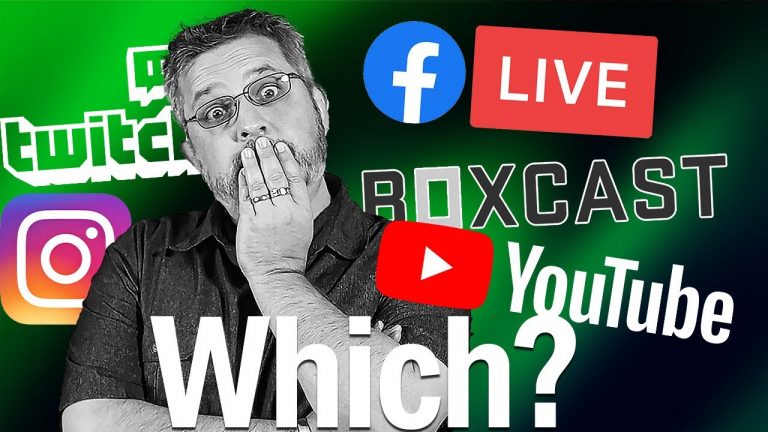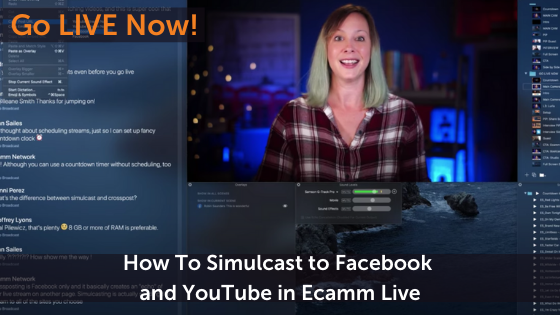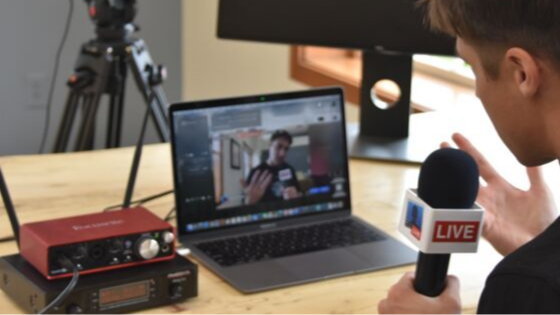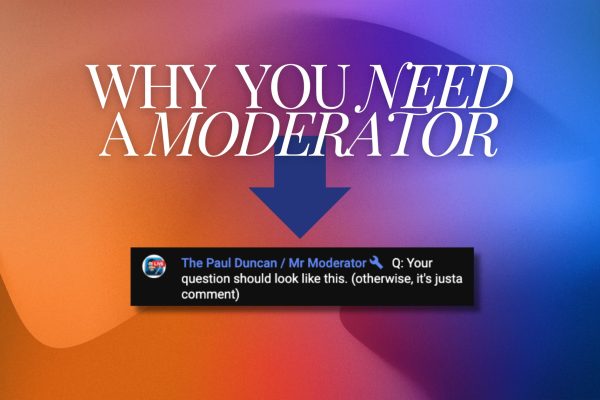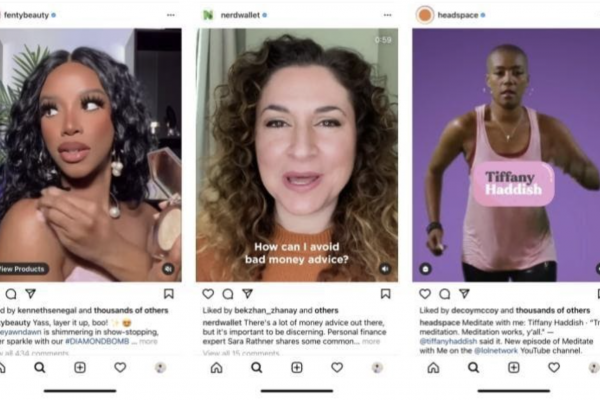There’s no shortage of options when it comes to where you can live stream. There are tons of social media platforms to choose from, including: Facebook Live, YouTube Live, Instagram Live, IGTV, Tik Tok, Twitter, Twitch, LinkedIn Live, and even direct to your website or church online platform. The big question is: what is worth the church’s presence?
In this post we’ll cover
- What are the major social media platforms for live streaming?
- Pros and cons of the social media platforms
- What makes the most sense for churches?
Watch the full episode
Stream Your Church with the Church Media Guys is here to help churches succeed. In each video, Justin and Dave tackle questions having to do with church live streaming and virtual church.
Want to try Ecamm Live for free? Visit www.getecamm.com to start your 14-day free trial today.
Download the FREE Guide: “Live Streaming for Churches – The Easy Way”
When you’re just getting started with live streaming, one of the most important questions you should be asking yourself is where am I going to stream to?
The question hiding behind this one is where are my people?
You want to make sure that you’re bringing your message to the people who need to hear it. So you should be thinking about where your audience spends the majority of their time.
Go Where the People Are
Unsurprisingly, the vast majority of people in any church are going to be on Facebook. That’s where we all go to connect with people. It’s where we plan our family reunions and share photos and participate in groups.
Facebook is just a part of our daily lives now. So it makes sense that Facebook is the place that you want to launch first.
It’s actually a lot like church building. You may initially decide to build your church in the neighborhood you live in or know well. That’s a great way to start, but at some point you’re going to want to start looking at the demographics. Who do you want to each? The people in your neighborhood may not be the people you’re trying to serve.
The Different Social Media Platforms
We’re going to break down the different platforms for you. We’ll show you what streaming to each of them looks like so you can make the best decisions for your church.
Remember that you never want to spread yourself too thin. It’s not helpful to be on every single platform if you can’t be engaging and helpful there. It’s kind of like standing on the corner with a bullhorn and preaching the message. What you need is a conversation and the ability to speak with people.
The same is true on Facebook or any platform. It’s not enough just to be present. You have to actually be engaging. We always say that we don’t want the pastor to just show up at 11, preach, and then leave at 12. There needs to be some time for the pastor to engage with the congregation and be present, aware, and have conversations. So if you’re just going to broadcast and not monitor what’s going on on these streams, you’re missing the mark entirely.
Start with YouTube
The one caveat to the above is that you should probably consider YouTube from the start. The reason why is two fold.
- YouTube is a search engine. The second largest in the world, actually. So having a presence there is always a good thing as far as getting people to discover your content.
- It allows you to live stream at a higher quality than Facebook. YouTube doesn’t compress the files down at all, so the videos always look their best.
Another important reason to consider YouTube is that you can easily embed a YouTube video (live or prerecorded) onto your website. This means that it’ll be easy for everyone to find it. Here is how to embed a YouTube live video and the chat onto your site.
It’s the lowest common denominator so you don’t necessarily have to try to immediately engage and build community on the platform. You’re just making it easy for everyone to find your content.
Okay, let’s break down each platform starting with Facebook.
Facebook Live
Pretty much the entire world is on Facebook, including your audience. As far as live streaming your church service to Facebook, you’ll want to make sure to follow all of the best practices, including making sure that you have good video and audio.
Within a few minutes of going live to Facebook, you’ll see you’ll get lots of people tuning in for a few seconds. It’s basically virtual word of mouth and you’ll get a lot of it. But, you’ll find that if you’re streaming long form videos (30 minutes or 45 minutes or more), you’ll start to lose people.
The reason for this is that Facebook is an engaging platform, but it’s not a place you go to to watch long form content. When was the last time you said to yourself “I want to watch something. I’m going to turn on Facebook.”
If you spend an hour on Facebook, it’s more likely that you watched a 15 second clip of something engaging and then you kept scrolling to see other things and somehow that turned into an hour.
An exception to this is if you have a strong presence on Facebook and you’ve done a good job promoting your video and letting your followers know what to expect. These are your ambassadors and they’re more likely to show up and stay for the length of your video because they’ve set aside that time.
So Facebook is a great place to start live streaming to, but be aware that your engagements are going to be pretty low outside of the people that are already connected to you – your church ambassadors.
The best way to start with Facebook Live is to include a mix of live stream broadcasts of things like your church service AND Quick Hits like little thoughts from your pastor or church leaders that are shot on a phone and feel a lot more raw/authentic.
You can also take your long form sermon, or even your hour long service and trim it down and also create some short clips. Some people will definitely sit there and watch a 90 second video on Facebook and it could pique their interest enough to find the full sermon.
Facebook Live also has notifications, so your followers can get reminders within Facebook when you go live, which is a great way to keep your audience engaged.
YouTube Live
Let’s move on to YouTube Live. YouTube has a lot of the same strengths as Facebook, along with the archival strengths of being YouTube. The difference is that your audience might not just be on YouTube as much.
So let’s talk about the benefits of YouTube. From the start, the biggest benefit of YouTube is that it’s a search engine that’s open to everyone. This means that anyone can click on your live video and immediately watch it. They can also watch on their phone, computer, even their smart TV. You can’t do that with Facebook. Or at least, not nearly as easily.
You can also optimize your videos on YouTube by adding a title, description, keywords, and a great thumbnail image to capture attention. All of these things help your video become more discoverable.
In addition to that, you can easily take a look at analytics within YouTube and do some research to see what others are sharing and what’s performing well. This will help you figure out what videos your audience may want to see, which will result in more views and increased discoverability.
This is the most important part when it comes to YouTube. You need to spend the time to make sure that your title, description, and especially your thumbnail image, are all eye-catching. People are not going to be specifically looking for you. They’ll see your video come up as they scroll and it has to be interesting enough for them to want to click through to watch. You need to grab people’s attention.
Similar to Facebook Live, YouTube Live does have chat and people can leave you comments and engage with you while you’re live. If you have an active audience, you should definitely take advantage of this and answer questions and say hi to those watching.
Unlike Facebook, long form, helpful content is popular on YouTube and you can live stream or upload longer videos without the same risk of losing your viewers part way through. There are some popular YouTubers (like Nick Nimmin, for example) who do hours long live streams and maintain huge viewership throughout, so don’t shy away from sharing longer videos here — as long as the content is your focus.
As we said above, you can also embed your YouTube videos and YouTube live streams onto your website to increase your views. This means that your viewers don’t have to be on YouTube to see your video, but it does contribute to your overall views and helps you grow your YouTube channel and increase your influence there.
In many ways, embedding a YouTube Live on your site is a much better option than hiring a church live streaming company to handle that for you because it not only makes it easy and clean for your congregation to find your video, but it’s helping you to become more discoverable in the YouTube platform at the same time.
Instagram Live and IGTV
Before we dive too deep into this topic, it’s important to note that you cannot currently use an encoder like Ecamm Live to live stream to Instagram or IGTV.
Like Facebook, people don’t really go to Instagram to sit and watch for hours, but sometimes they can find themselves doing just that because of Instagram’s “watch more” feature.
Instagram is a is a beautiful platform. It’s entirely based on a visual experience with gorgeous photos and video clips. It’s meant for users to scroll through and pick something to interact with and then keep scrolling.
When it comes to Instagram Live, you can open Instagram on your phone and hit the go live button and your live video will appear up in the Stories. The live video will stay up there for 24 hours unless you archive it in IGTV and that gives you a bit more flexibility to promote it in your Instagram feed and other places.
What you want to achieve is having someone watch a clip of your IGTV in Instagram and then jump into IGTV to watch the rest. That’s what Facebook (who owns Instagram) wants you to do. As we said above, it is also a mobile-first platform and doesn’t work with Ecamm Live. You’ll also need to remember that you’ll likely be on wifi or your data plan to do this so you’ll want to have a strong connection.
The other important thing to keep in mind that since Instagram is mobile-first, it’s also vertical and a lot of Selfie Mode looking content. If you’re going to try to broadcast content on this platform, you’re best off going with Quick Hits and shorter video like mini Q+As to engage followers and not an entire church service.
Twitter Live
Twitter is great for individuals and for large brands, but is a bit more difficult for churches and local businesses. Rather than setting up an account for your church, consider having your church leaders have their own personal Twitter accounts. This way they can engage, talk, and communicate with members in the Community.
When it comes to live streaming to Twitter, you’ll want to only consider it if you have a presence there. Twitter Live has great reach, but unfortunately it’s also filled with trolls.
We’d recommend not live streaming to Twitter. Rather use it as a tool to share your YouTube Live stream links as an added promo tool.
Twitch
Twitch is a very different environment from the other platforms. It’s a really different beast. It relies heavily on engagement and chat moderation. So much so that many not only have multiple chat moderators, but they actually have script commands, chat commands, responses, and graphics that pop up and ping to get your attention.
Twitch also has a very young audience. So a traditional church service is going to be really hard to run on Twitch. There are some church services on Twitch that are doing really great. For example, you can look up God Squad Church Daily, but they are a Twitch-specific church service. They are very good about communicating and connecting with the people. They also use Discord to keep their members informed. In short, you’re going to have to be really intentional if you plan on using Twitch. It requires a lot of attention and is labor intensive.
Tik Tok
If you’re going to interact on Tik Tok, you need to watch what’s going on there. See what people are successful with. Don’t just join the platform and start up something new. You’ll need to research a bit and understand what the platform is like and what people are talking about.
Like Instagram, Tik Tok is a mobile-only platform. You can’t use an app like Ecamm Live to live stream there. You also don’t just want to broadcast your church service on Tik Tok. That’s not what their users want to see. You can use it to build relationships. Especially if you can figure out how to share something that resonates with their audience. The key thing to remember is that it’s got to be personal and it’s got to be short.
We’d advise waiting before jumping into Tik Tok. There’s a lot about this platform that is up in the air at the moment.
Streaming to Your Website
All roads should be leading to your website. And the reason is because that’s what you own.
Even if you have a huge presence on YouTube or a thriving Facebook group with thousands of members, it’s really important to remember that those are rented spaces. At any point, those networks could change their rules, lock you out, or even close completely.
We don’t own Facebook or YouTube or Twitter or Instagram, but we do own our website.
For this reason (and a few others), you should be streaming to your website. Or at least hosting your streams on your site. For example: you may have older people in your church. This is our experience. Older people in our in our church will more readily go to the church’s website and click live to watch. They may not be on Facebook or have a smartphone or know to look on YouTube.
We have a woman in our church who doesn’t own a smartphone. What she does have is a laptop. So on Sunday mornings she sits down, searches for our website, and clicks on watch live to see the sermon. That’s how it happens. There are a lot of people out there that are doing that. So you need to have it in that place.
Do you need to have a hosting or do you need to go pay for a Vimeo Pro account?
No, you really don’t. You can just embed the YouTube live stream. It’s easy, free, and searchable because it’s YouTube. And you’ll be killing two birds with one stone. Get views for your YouTube channel and make your content accessible.
Whatever you decide to do, just make sure that your church’s website links through to everything so that it’s the central hub. That way, when people are searching for a church nearby, they’ll find you and know how to connect in.
We’re here to help!
Wherever you are right now with your church, you’re not alone and we’re here to help. Watch Stream Your Church videos on YouTube.
Or…
Visit Church Training Academy to learn more about the skills you need to maximize your ministry.
Or…
Join the Ecamm Live Community to network with other live streamers like you.
Or…
Grab your free 14-day trial of Ecamm Live and get started today.

